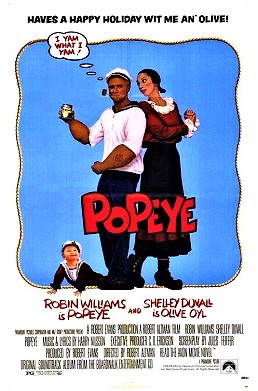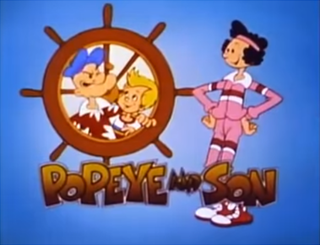
Olive Oyl is a cartoon character created by E. C. Segar in 1919 for his comic strip Thimble Theatre. The strip was later renamed Popeye after the sailor character that became the most popular member of the cast; however, Olive Oyl was a main character for a decade before Popeye's 1929 appearance.

Bluto, at times known as Brutus, is a cartoon and comics character created in 1932 by Elzie Crisler Segar as a one-time character, named "Bluto the Terrible", in his Thimble Theatre comic strip. Bluto made his first appearance on September 12 of that year. Fleischer Studios adapted him the next year (1933) to be the main antagonist of their theatrical Popeye animated cartoon series.

Elzie Crisler Segar, known by the pen name E. C. Segar, was an American cartoonist best known as the creator of Popeye, a pop culture character who first appeared in 1929 in Segar's comic strip Thimble Theatre.

Mae Questel was an American actress. She was best known for providing the voices for the animated characters Betty Boop, Olive Oyl and numerous others.

Popeye is a 1980 American musical comedy film directed by Robert Altman and produced by Paramount Pictures and Walt Disney Productions. It is based on E. C. Segar's Popeye comics character. The script was written by Jules Feiffer, and stars Robin Williams as Popeye the Sailor Man and Shelley Duvall as Olive Oyl. Its story follows Popeye's adventures as he arrives in the town of Sweethaven.

Popeye the Sailor Meets Sindbad the Sailor is a 1936 two-reel animated cartoon short subject in the Popeye Color Specials series, produced in Technicolor and released to theatres on November 27, 1936, by Paramount Pictures. It was produced by Max Fleischer for Fleischer Studios and directed by Dave Fleischer, with the title song's music composed by Sammy Timberg and lyrics written by Bob Rothberg. The voice cast includes Jack Mercer as Popeye, Gus Wickie as Sindbad the Sailor, Mae Questel as Olive Oyl and Lou Fleischer as J. Wellington Wimpy.

Popeye the Sailor Meets Ali Baba's Forty Thieves is a two-reel animated cartoon short subject in the Popeye Color Specials series, produced in Technicolor and released to theatres on November 26, 1937 by Paramount Pictures. It was produced by Max Fleischer for Fleischer Studios, Inc. and directed by Dave Fleischer. Willard Bowsky was head animator, with musical supervision by Sammy Timberg. The voice of Popeye is performed by Jack Mercer, with additional voices by Mae Questel as Olive Oyl, Lou Fleischer as J. Wellington Wimpy and Gus Wickie as Abu Hassan.

Popeye and Son is an American animated comedy series based on the Popeye comic strip created by E.C. Segar and published by King Features Syndicate. Jointly produced by Hanna-Barbera and King Features subsidiary King Features Entertainment, the series aired for one season of thirteen episodes on CBS. It is a follow-up to The All New Popeye Hour. Due to Jack Mercer's death in 1984, Maurice LaMarche voiced Popeye, while much of the cast of The All New Popeye Hour reprised their respective roles, with the exception of Daws Butler. However, Nancy Cartwright, who was trained by Butler, voiced Woody in the series.

Popeye's Voyage: The Quest for Pappy is a 2004 animated Christmas television special produced by Mainframe Entertainment for Lions Gate Entertainment and King Features Entertainment, in association with Nuance Productions. The special, created to coincide with the 75th anniversary of the Popeye the Sailor comic strip character from E. C. Segar's Thimble Theatre, first aired on Fox on December 17, 2004, and was rebroadcast on the same network on December 30, 2005.
Swee'Pea is a character in E. C. Segar's comic strip Thimble Theatre / Popeye and in the cartoon series derived from it. His name refers to the flower known as the sweet pea. Before his addition to the animated shorts, the name "Sweet Pea" was a term of affection used by main character Popeye. In the cartoon We Aim to Please, he addressed girlfriend Olive Oyl that way.

Wheatena is an American high-fiber, toasted-wheat cereal that originated on Mulberry Street in New York City, New York, c. 1879, when a small bakery owner began roasting whole wheat, grinding it, and packaging it for sale under this brand name.

I Yam What I Yam is the second Popeye theatrical cartoon short, starring William "Billy" Costello as Popeye, Bonnie Poe as Olive Oyl and Charles Lawrence as Wimpy. The source of the quote is the comic strip, Thimble Theatre by E. C. Segar, in which Popeye first appeared. This is a paraphrase of words spoken by Popeye in the comic strip.

Popeye the Sailor is an American animated television series produced for King Features Syndicate TV starring Popeye that was released between 1960 and 1963 with 220 episodes produced. The episodes were produced by a variety of production studios and aired in broadcast syndication until the 1990s.

The All New Popeye Hour is an American animated television series produced by Hanna-Barbera Productions and King Features Entertainment. Starring the comic strip character Popeye, the series aired from 1978 to 1983 Saturday mornings on CBS. Despite the series' mixed reception, it was a hit for King Features Entertainment.

Popeye the Sailor is an American animated series of short films based on the Popeye comic strip character created by E. C. Segar. In 1933, Max and Dave Fleischer's Fleischer Studios, based in New York City, adapted Segar's characters into a series of theatrical cartoon shorts for Paramount Pictures. The plotlines in the animated cartoons tended to be simpler than those presented in the comic strips, and the characters slightly different. A villain, usually Bluto, makes a move on Popeye's "sweetie", Olive Oyl. The villain clobbers Popeye until he eats spinach, giving him superhuman strength. Thus empowered, Popeye makes short work of the villain.

Popeye the Sailor is a fictional cartoon character created by Elzie Crisler Segar. The character first appeared on January 17, 1929, in the daily King Features comic strip Thimble Theatre. The strip was in its tenth year when Popeye made his debut, but the one-eyed sailor quickly became the lead character, and Thimble Theatre became one of King Features' most popular properties during the 1930s. Following Segar's death in 1938, Thimble Theatre was continued by several writers and artists, most notably Segar's assistant Bud Sagendorf. The strip continues to appear in first-run installments on Sundays, written and drawn by R. K. Milholland. The daily strips are reprints of old Sagendorf stories.

Seasin's Greetinks! is a Popeye theatrical Christmas-themed cartoon short, starring William "Billy" Costello as Popeye and Bonnie Poe as Olive Oyl and William Pennell as Bluto. It was released on December 17, 1933 and is in the Popeye the Sailor series of theatrical cartoons released by Paramount Pictures.

Let's You and Him Fight is a Popeye theatrical cartoon short released in February 16, 1934, starring William "Billy" Costello as Popeye, Bonnie Poe as Olive Oyl, William Pennell as Bluto and Charles Lawrence as the announcer.

Popeye is a Japan-exclusive Game Boy video game based on the comic strip of same name licensed from King Features Syndicate.

Popeye: Rush for Spinach is a Game Boy Advance video game based on the comic strip of same name created by E. C. Segar, licensed from King Features Entertainment. It was developed by French studio Magic Pockets and published by Namco Hometek in 2005, and Atari Europe in 2006.


















